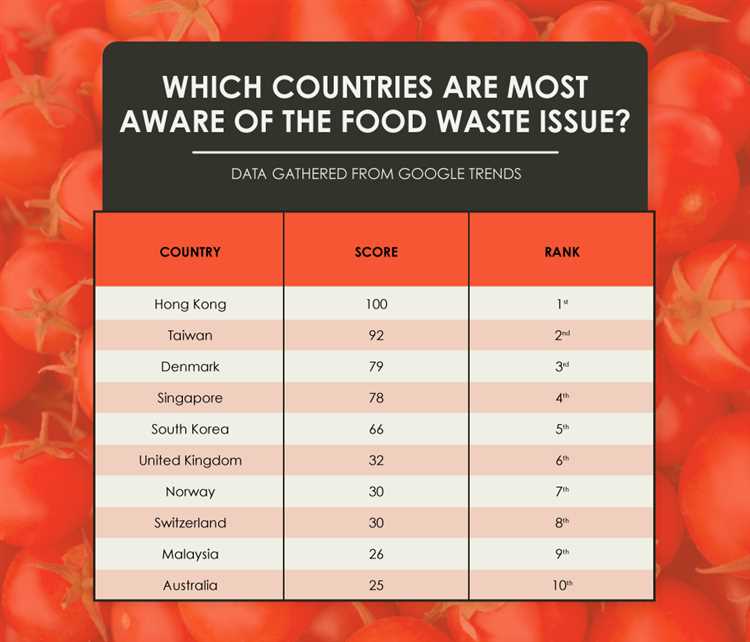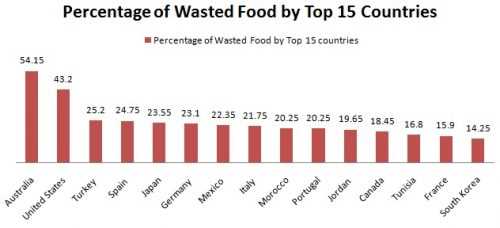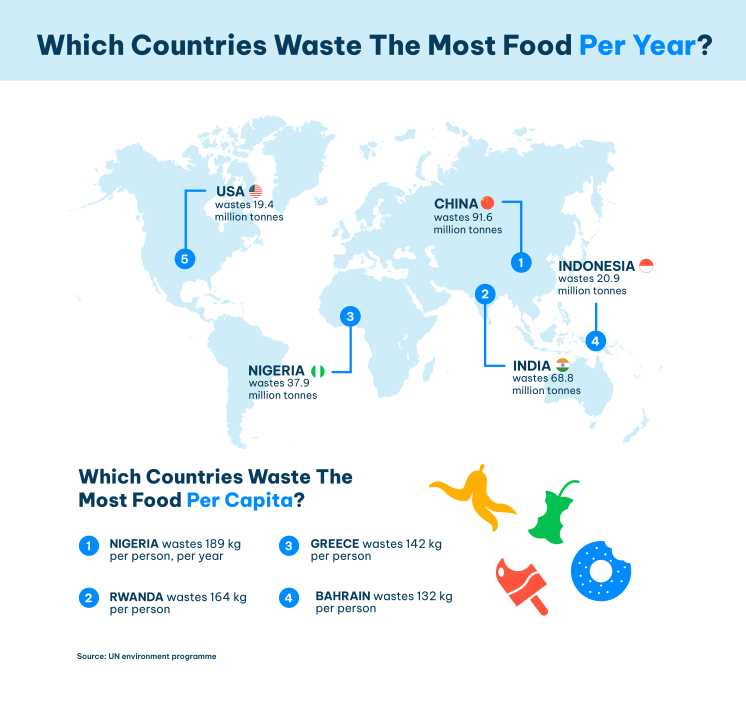
Food waste is a global issue that has long been a concern for both individuals and governments alike. In many countries around the world, a significant amount of food goes to waste every year, despite the fact that millions of people suffer from hunger and malnutrition.
In recent years, numerous studies and reports have been released highlighting the countries with the highest rates of food waste. These reports shed light on the extent of the problem and can serve as a wake-up call for policymakers, as well as individuals, to take action.
One country that consistently ranks at the top of the list is the United States. According to a report by the United Nations, the United States wastes approximately 40% of its food supply every year. This is a staggering statistic and highlights the need for improved food management systems and consumer education in the country.
Another country with a high food waste rate is the United Kingdom. Reports suggest that the UK wastes nearly 9 million tons of food each year. This accounts for a significant portion of the country’s overall waste and has prompted the government to take action to reduce this figure.
Australia is also among the top countries with a high food waste rate. It is estimated that Australians waste around 7.3 million tons of food annually, which is equivalent to about 298 kilograms per person. Efforts are being made in the country to address this issue and promote sustainable food practices.
While these statistics are concerning, they also present an opportunity for change. By raising awareness, implementing effective policies, and encouraging individual action, countries can work towards reducing their food waste rates and creating a more sustainable future.
- United States
- Causes of Food Waste in the United States
- Efforts to Reduce Food Waste
- Germany
- Netherlands
- Efforts to Reduce Food Waste
- Economic and Environmental Impacts
- Australia
- Canada
- United Kingdom
- Causes of Food Waste in the United Kingdom
- Efforts to Reduce Food Waste in the United Kingdom
- Question-answer:
- Which country has the highest food waste rate?
- What are the main factors contributing to the high food waste rates in these countries?
- How does food waste affect the environment?
- What are some solutions that can help reduce food waste in these countries?
- Are there any countries that have successfully reduced their food waste rates?
United States

The United States is one of the top countries worldwide with the highest food waste rates. Despite being one of the wealthiest countries, it also has one of the highest levels of food wastage. According to the U.S. Department of Agriculture (USDA), approximately 30-40% of the food supply in the United States goes to waste each year.
This high level of food waste has serious economic, social, and environmental consequences. In economic terms, it results in a loss of billions of dollars each year. This wasted food could have been used to feed the millions of Americans who struggle with food insecurity.
Furthermore, food waste contributes to greenhouse gas emissions, as decomposing food in landfills produces methane gas, a potent greenhouse gas that contributes to climate change. In addition, the resources used to produce the wasted food, such as water, land, and energy, are also wasted.
Causes of Food Waste in the United States
There are several factors that contribute to the high levels of food waste in the United States. One major factor is consumer behavior, including excessive purchasing, improper storage, and preference for aesthetically pleasing produce.
Food waste also occurs at the production and supply chain levels. This includes overproduction, spoilage during transportation, and strict industry standards for appearance, resulting in the rejection of perfectly edible food.
Efforts to Reduce Food Waste
The United States has taken steps to address the issue of food waste. Organizations and initiatives have been launched to promote food recovery and redistribution, as well as educate consumers about the importance of reducing food waste.
Several states have implemented policies to divert food waste from landfills, such as mandatory composting or anaerobic digestion programs. In addition, businesses and restaurants have implemented practices to reduce food waste, such as donating excess food to food banks or using food waste as animal feed or compost.
However, more work needs to be done to effectively reduce food waste in the United States. This includes continuing to educate consumers about proper food storage and purchasing habits, implementing policies to encourage food waste reduction, and promoting innovative solutions to divert food waste from landfills.
In conclusion, the United States faces significant challenges with food waste. While efforts are being made to reduce food waste, it is crucial for both individuals and organizations to prioritize and take action to minimize food waste and its impact on the economy, society, and the environment.
Germany
Germany is one of the top countries with a high food waste rate. Despite its efficient food production and distribution systems, a significant amount of food goes to waste in the country every year.
One of the main reasons for food waste in Germany is the strict quality standards set by retailers. If a product does not meet these standards, it is often discarded, even if it is still perfectly edible. This leads to a substantial amount of food being wasted before it even reaches the consumer.
Another contributing factor is the lack of awareness and education about food waste. Many people in Germany do not realize the impact of their actions and do not take steps to reduce food waste in their own households.
To combat this issue, Germany has implemented various initiatives and programs to reduce food waste. These include implementing stricter regulations on food labeling, promoting food donations, and encouraging consumers to plan their meals and shop more responsibly.
Additionally, many organizations and NGOs in Germany are actively working to tackle food waste. They collect surplus food from supermarkets and restaurants and distribute it to those in need. These initiatives are helping to raise awareness about food waste and provide better access to food for vulnerable populations.
Overall, while Germany has made efforts to address the issue of food waste, there is still work to be done. Continued education and awareness campaigns, along with policy changes, can help reduce food waste and create a more sustainable food system in the country.
Netherlands

The Netherlands is known for its advanced agricultural sector and innovative food processing techniques. However, it also has one of the highest food waste rates in the world. According to a report by the United Nations, the Netherlands wastes around 2.5 million tonnes of food each year.
There are several factors contributing to the high food waste rates in the Netherlands. One of the primary reasons is the strict cosmetic standards imposed by supermarkets and retailers. Produce that does not meet these standards, such as fruits and vegetables with slight imperfections, is often discarded, leading to significant food waste.
In addition to cosmetic standards, the Netherlands also faces challenges in its food supply chain. The country’s highly efficient agricultural and distribution systems sometimes lead to overproduction and subsequent waste. Additionally, ineffective storage and transportation methods can contribute to food spoilage.
Efforts to Reduce Food Waste
The Netherlands is taking steps to address its high food waste rates. One initiative is the “United Against Food Waste” campaign, launched in 2020. This campaign aims to raise awareness about food waste and encourages consumers, businesses, and policymakers to take action.
The government has also introduced regulations to reduce food waste. For example, supermarkets are now required to donate edible food that is nearing its expiration date to food banks and other charitable organizations. Additionally, the government has set a target to reduce food waste by 50% by 2030.
The Netherlands is also embracing technology to tackle food waste. Start-ups and organizations are developing innovative solutions such as smartphone apps that connect consumers with discounted food nearing its expiration date, reducing waste while providing affordable options.
Economic and Environmental Impacts
The high food waste rates in the Netherlands have both economic and environmental consequences. The economic impact includes lost revenue for farmers and increased costs for businesses. Additionally, resources used to produce, transport, and dispose of food that goes to waste are wasted, leading to unnecessary environmental damage.
Reducing food waste not only benefits the economy and the environment but also has social implications. By reducing food waste, more food can reach those in need, helping to alleviate hunger and reduce inequality.
Australia
Australia is one of the top countries with a high food waste rate. Despite being known for its vast agricultural resources and efficient food production systems, Australia wastes a significant amount of food every year.
According to a report by the Australian government, it is estimated that around 7.3 million tonnes of food is wasted annually in Australia, which is equivalent to 298 kilograms per person. This translates to a total value of approximately $20 billion.
There are several factors contributing to Australia’s high food waste rate. One of the main reasons is consumer behavior, where individuals tend to buy more food than they need and often throw away leftovers. Food retailers and restaurants also contribute to the problem by discarding perishable items that are approaching their expiration dates.
The Australian government has recognized the severity of the issue and has implemented initiatives to tackle food waste. These include awareness campaigns, collaborations with food industry stakeholders, and providing grants to organizations focused on reducing food waste.
Efforts are also being made at the community level, with initiatives such as food rescue programs and community gardens. These programs aim to redistribute surplus food to those in need and promote sustainable practices.
While progress is being made, there is still a long way to go in reducing Australia’s food waste rate. It requires continued efforts from all sectors of society, including individuals, businesses, and the government, to create a more sustainable food system.
Canada
Canada is one of the countries with a high food waste rate. Despite being known for its vast agricultural production, Canada wastes a significant amount of food each year.
One of the factors contributing to food waste in Canada is consumer behavior. Many Canadians buy more food than they can consume, leading to a large amount of food being thrown away. In addition, inadequate storage and preservation methods also contribute to food waste.
Efforts are being made in Canada to reduce food waste. Organizations and initiatives are working towards educating consumers about proper portion sizes, meal planning, and reducing food waste at home. Efforts are also being made to divert food waste from landfills and use it for composting or energy production.
Overall, Canada recognizes the need to address the issue of food waste and is taking steps to reduce it. By changing consumer behavior and implementing sustainable practices, Canada can work towards minimizing food waste and its impact on the environment.
United Kingdom
The United Kingdom is one of the countries with the highest food waste rates globally. Despite efforts to reduce food waste, the country still struggles with significant wastage in its food supply chain.
Causes of Food Waste in the United Kingdom
One of the main causes of food waste in the United Kingdom is consumer behavior. Many households in the country buy more food than they actually need and end up throwing away a significant portion of it. Additionally, changing lifestyles and eating habits have led to a rise in eating out and takeaway meals, resulting in increased food waste.
Another major contributor to food waste in the United Kingdom is the retail sector. Supermarkets and grocery stores often reject perfectly edible food due to aesthetic reasons or overstocking. This leads to a significant amount of food being wasted before it even reaches consumers.
Efforts to Reduce Food Waste in the United Kingdom
The United Kingdom has taken several steps to combat food waste. One such initiative is the introduction of The Food Waste Reduction Roadmap in 2018. This voluntary agreement brings together leading retailers, manufacturers, and hospitality companies to tackle food waste collectively. The roadmap includes a target to reduce food waste by 20% by 2025.
The United Kingdom also implemented the Waste and Resources Action Programme (WRAP) to help businesses and individuals reduce food waste. WRAP provides guidance, support, and resources to organizations to measure and reduce their food waste.
- Another notable initiative is the Love Food Hate Waste campaign led by WRAP. This campaign raises awareness about the issue of food waste and provides practical tips and advice on how to reduce food waste at home.
- The FareShare charity in the United Kingdom also plays a crucial role in redistributing surplus food from the food industry to charities and community organizations, ensuring that edible food is not wasted.
Despite these efforts, there is still a long way to go in reducing food waste in the United Kingdom. The government, businesses, and individuals must continue to work together to address this issue and create a more sustainable food system.
Question-answer:
Which country has the highest food waste rate?
The country with the highest food waste rate is Australia.
What are the main factors contributing to the high food waste rates in these countries?
The main factors contributing to high food waste rates in these countries include inefficient food production and distribution systems, lack of awareness and education about food waste, and excessive consumerism.
How does food waste affect the environment?
Food waste has significant negative impacts on the environment. When food decomposes in landfills, it produces methane, a potent greenhouse gas that contributes to climate change. Additionally, the resources used to produce and transport wasted food, such as water and energy, are also wasted.
What are some solutions that can help reduce food waste in these countries?
Some solutions to reduce food waste in these countries include implementing better food production and distribution practices, educating consumers about the importance of reducing food waste, implementing policies and regulations to encourage food donation and composting, and engaging in consumer campaigns and initiatives to promote mindful consumption.
Are there any countries that have successfully reduced their food waste rates?
Yes, there are countries that have successfully reduced their food waste rates. For example, South Korea has implemented various initiatives, such as a mandatory food waste recycling program and educational campaigns, which have led to significant reductions in food waste.